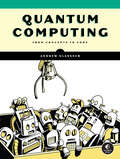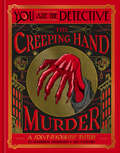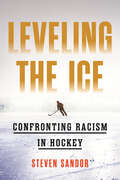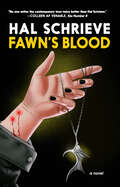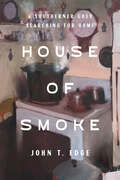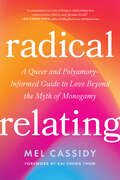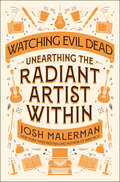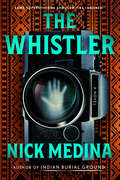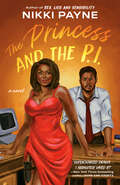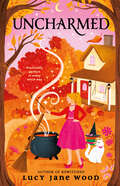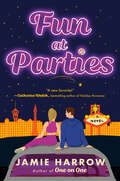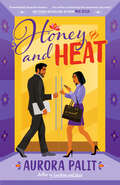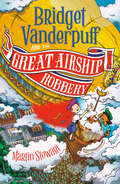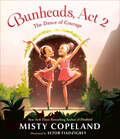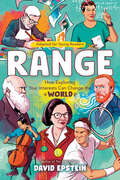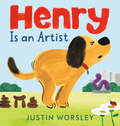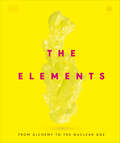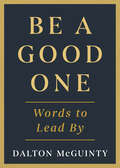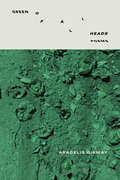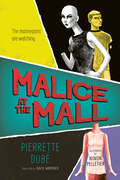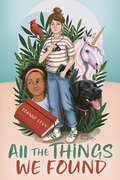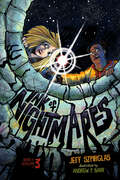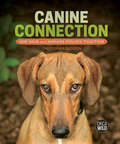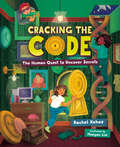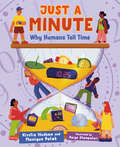- Table View
- List View
Quantum Computing: From Concepts to Code
by Andrew GlassnerA friendly introduction to quantum programming.What if you had a computer that could process billions of different inputs at the same time?Quantum computing is a radically new way to think about algorithms and data. It can feel mysterious or technically challenging, but it doesn&’t have to be. If you want to understand how quantum computers work—and how to program them—this friendly, self-contained guide is for you.This approachable yet rigorous book walks you step-by-step through quantum computing fundamentals, such as superposition, quantum gates, interference, entanglement, and measurement, then teaches you how to write real quantum programs.Along the way, you&’ll:Understand how to store and transform quantum informationGrasp the surprising process of quantum measurementExplore Simon&’s, Grover&’s, and Shor&’s algorithmsWrite and run your own quantum code using free simulators and live hardwareAuthor Andrew Glassner is known for turning complex topics into accessible and enjoyable learning experiences. In this book, he brings visual thinking, clarity, context, and precision to the strange and fascinating world of quantum programming. All the ideas and math are built up slowly so you&’ll master every step.Whether you&’re a programmer, student, educator, scientist, poet, or anyone else who loves new ideas that stretch your mind, this is the guide that will take you from &“What is a qubit?&” to writing and running working quantum algorithms with curiosity, creativity, and confidence.
You Are the Detective: The Creeping Hand Murder (You Are the Detective)
by Maureen Johnson Jay CooperNovember 1933. London. Seven people receive mysterious letters. Someone knows their terrible secrets. They are summoned to a posh townhouse where one is stabbed right in front of the others, but somehow no one saw a thing. Can you help Scotland Yard solve the mystery?A &“delightfully witty interactive mystery packed with theatrical characters and exciting twists&” (G.T. Karber, author of Murdle) from the bestselling author and illustrator of Your Guide to Not Getting Murdered in a Quaint English VillageDear Detective,Surely you have seen the papers and read about the dreadful murder of the American novelist—stabbed while in a room with six other people, and yet no one went near him or saw the murder occur. The crime is so devious, so logistically impossible, that it seems to have been committed not by a person but by a disembodied hand.I must confess that we are at a loss. Who wrote the poison pen letters that lured these seven people to this deadly gathering? A poet, an earl, an actress, a cook, a telephone operator, and a lothario . . . What do they have in common? And how could a man be stabbed in a room full of suspects, even though no one went near him or saw a thing?We have had our best people on the case, Detective, and we still can&’t make heads or tails of it. We are giving this case file to you. Can you decipher the clues, decode the witness statements, and identify the murderer? You are our last hope. Can you help us crack the Creeping Hand Murder?Yours truly,Detective Chief Inspector of the Metropolitan Police
Leveling the Ice: Confronting Racism in Hockey
by Steven SandorA deep dive into the institutional racism and prejudice in the sport of hockey that persists across all levels - and how it will impact the future of the sportWhile professional sports leagues claim to promote diversity and inclusivity, institutional racism remains apparent in all sports, but especially hockey. In Leveling the Ice, sportswriter Steven Sandor challenges the perception that hockey is open to everyone and the idea that the hockey establishment wants more inclusion and diversity.Featuring interviews with NHL players of color like Darnell Nurse, Matt Dumba, Nazeem Kadri, Zach Whitecloud, Ethan Bear, Jason Robertson, Sandor reveals their stories of exclusion to highlight the deeply ingrained racism in the sport. The players share insights into the racism they faced while they built their careers as well as the racism, they still face today from the hockey establishmentFrom hockey&’s racist past to the ongoing reluctance of the hockey establishment to embrace grassroots diversity initiatives, Sandor delves into how members of communities of color (who only make up 5% of the NHL) are being driven away from the sport to more inclusive ones like soccer and basketball, despite the NHL&’s expansion to new markets and demographics with billion-dollar TV deals. Comprehensive and timely, Leveling the Ice grapples with how the institutional racism in hockey will directly affect the future of the sport.
Fawn's Blood: A Novel
by Hal SchrieveVampires, vampire slayers, and a bloodthirsty underground resistance converge in a campy YA fantasy about being a queer teen in a world that wishes they did not exist.The librarian and critically acclaimed author of Out of Salem puts a pulpy spin on vampire fiction, and bites back at anti-trans moral panic.Fawn and Silver share nearly everything: coming out together as trans in their small Maryland town, clocking a copious number of hours in detention, and spending their sleepovers secretly making out. They&’re also uniquely obsessed with vampires, who are being hunted, imprisoned, and executed for the danger they allegedly pose to human life.Meanwhile in Seattle, Rachel's relationship to her girlfriend and her membership in her mother's vampire-slaying vigilante group is thrown into question when she's bitten by her mother's nemesis and awakes with a craving for blood. When Silver disappears and Fawn goes west in search of him, her and Rachel&’s fates converge, both falling into the hands of Cain, an edgelord vampire known for his proselytizing for the drinking of human blood.But in discovering hidden tunnels and secret bars, youth shelters and punk shows and safe houses, Fawn find herself in the middle of a vampire underground in Seattle—an organized resistance keeping each other alive through a network of blood distribution and protection from slayers.Fawn&’s Blood is a timely antidote to the anti-trans moral panic of today. Playing with tropes about monstrousness, predation, and villainy, this multi-voiced vampire novel offers a paranormal YA fantasy full of complicated queer characters—human and monster alike—all of whom are simply trying to survive in a world that wants them dead.
House of Smoke: A Southerner Goes Searching for Home
by John T. EdgeThe author of The Potlikker Papers: A Food History of the Modern South tells his own story this time. Of growing up in a house wrecked by violence and a South haunted by racism. And of how his search for home led him to find escape and belonging through food. Until he realizes that gathering at the table is just one small step toward reckoning.&“A story for all Americans on a path to self-awareness, honesty, and love.&”—Wright Thompson, New York Times bestselling author of Pappyland and The BarnIn this unflinching and moving memoir, John T. Edge takes us on a quest for home in a South that has both held him close and pushed him away, as he tries and fails and tries again to rewrite the stories he inherited. Born in a house where a Confederate general took his first breath and the Lost Cause narrative was gospel, troubled by the violence he witnessed as a boy, Edge ran from his past, searching for a newer and better South. As founding director of the Southern Foodways Alliance and a contributor to newspapers and magazines, he told stories that showcased those possibilities.In the process, Edge became one of the most visible and powerful voices in American food...until he found himself denounced by the audience he once guided, faced down the limits of his work, and returned to his origins to find himself once again. Beginning in Georgia and concluding in Mississippi, his search spans the Deep South and charts a very American story of the truth telling and soul searching it takes to love your people and your place.
Radical Relating: A Queer and Polyamory-Informed Guide to Love Beyond the Myth of Monogamy
by Mel CassidyA provocative, trauma-informed guide to post-monogamy—how to build liberated relationships rooted in empowerment, equity, and authenticity With practical somatic exercises, reflection prompts and a relational toolkit—also includes a glossary of polyamory, non-monogamy, and alternative relationship termsThis book is for polyamorists who want to practice their non-monogamy with more feminism, more queerness, and more community building. It&’s for monogamists who don&’t want to do relationships on autopilot. It&’s for everyone who dearly believes a better way to love and live exists. It&’s for change makers who aspire to re-wild the ways we love.An empowering guide to imagining (and living) better relationships, Radical Relating pushes back on the monogamy mandate. Author, somatic educator, and relationship coach Mel Cassidy explodes the often-unquestioned mainstream myths about the nuclear family structure: those that tell us your soulmate must be your sole mate. That sex is the only yardstick of relational success. That self-sacrifice and self-denial are necessary trade-offs for security and partnership. That we need to ride the relationship escalator all the way up, or we&’ll die alone.In four sections, Cassidy explains the why, what, how, and where of the Radical Relating model. They:Lay out clear-eyed analysis about why monogamy isn&’t working and explain the harms of unquestioned internalized mono-normativityOffer Reflective Journaling prompts, Somatic Pauses, and practical wisdom for assembling your Relational ToolkitExplain the trauma-informed pillars of Radical Relating: Orientation, Resilience, Resolution, and EngagementHelp you reorient to a new map for relating that&’s queer, anarchist, and somatically integratedHelp you build skills to understand and navigate your relationship landscapeExplore the intersections of monogamy, colonialism, patriarchy, and capitalism and illuminate how monogamous relationship structures emerged with one goal in mind: to consolidate capitalMost books on non-monogamy focus on top-level logistics and play into beliefs that can inadvertently replicate oppressive structures. Radical Relating is different: it speaks to readers who want not only to open up their relationships or expand their sexual experiences, but claim a new and liberating ways to relate to each other, fulfill our authentic needs, and build true communities of care beyond monogamy.
Watching Evil Dead: Unearthing the Radiant Artist Within
by Josh MalermanFrom the bestselling author of Bird Box and Incidents Around the House, an impassioned book about a night that changed the author&’s life and put into perspective the writing life—and how you too can be inspired to face the fears that might hold you back from doing your best work&“A fun, modern take on Stephen King&’s On Writing . . . Malerman&’s trustworthy insights and experiences will no doubt offer its readers who are struggling creatively a healthy dose of inspiration.&”—Booklist, starred reviewOne night, bestselling author Josh Malerman—then just an aspiring writer—watched Sam Raimi&’s Evil Dead with his fiancée and two friends. It was a gathering that could&’ve gone unnoticed, another date night with a movie, but for Malerman, it became a landmark. It changed the course of his life, and it will inspire you to reflect on your own journey and to discover existing triumphs that are within you already.Describing the course of the night, Malerman reflects on his life, from his career as a musician to his stack of rough drafts, written prior to ever being published—and on how meeting the love of his life, a fellow creative, opened him to new experiences and new ways of viewing the world they now quest through together.Malerman deploys his own story to help readers not only write their unwritten stories but celebrate their uncelebrated victories: to find their voice, their vision, and their joie de vivre. By simply describing an uncommon and uncanny night, he guides aspiring writers beyond the blank page to the immortal life of the writer.
The Whistler
by Nick MedinaA young man is haunted by a mythological specter bent on stealing everything he loves in this unsettling horror from the author of Indian Burial Ground and Sisters of the Lost Nation.For fear of summoning evil spirits, Native superstition says you should never, ever whistle at night. Henry Hotard was on the verge of fame, gaining a following and traction with his eerie ghost-hunting videos. Then his dreams came to a screeching halt. Now, he's learning to navigate a new life in a wheelchair, back on the reservation where he grew up, relying on his grandparents&’ care while he recovers.And he&’s being haunted.His girlfriend, Jade, insists he just needs time to adjust to his new reality as a quadriplegic, that it&’s his traumatized mind playing tricks on him, but Henry knows better. As the specter haunting him creeps closer each night, Henry battles to find a way to endure, to rid himself of the horror stalking him. Worried that this dread might plague him forever, he realizes the only way to exile his phantom is by confronting his troubled past and going back to the events that led to his injury.It all started when he whistled at night....
The Princess and the P.I.
by Nikki PayneAn amateur online sleuth must enlist the help of a jaded PI to clear her name while taking down a shady tech start-up in this exhilarating romantic suspense novel.Fiona Addai is ready to set her plan in motion. To honor the anniversary of her brother&’s death, she&’s going to steal back his brilliant invention from the ruthless corporation that stole and claimed it as their own. As a famed Reddit detective known as @Princess_PI, Fiona has used her online connections and sleuthing skills to time every step down to the minute. But with one disastrous misstep, instead of getting justice, Fiona finds herself accused of murder.Maurice Bennett is no stranger to insomnia. These days, he&’s not losing sleep over the cases he&’s solving—but running from the one he couldn&’t. Instead, he&’s been settling for small-time scandals that don&’t stir up the guilt he&’s buried. But when he spots Fiona Addai at the center of a murder investigation, something clicks. And for the first time in a long while, Maurice feels that old spark of intrigue.However, Fiona is not the helpless damsel she appears to be. Sure, she needs Maurice&’s help to clear her name, but she&’s got conditions of her own: she wants a crash course in real-world detective work. Maurice isn&’t exactly thrilled. With every late-night stakeout and tension-filled interrogation, their partnership, rife with tension and unexpected chemistry, unravels a dangerous web of corporate crime and familial secrets. To bring the real killer to light, they'll need to trust each other and that might be the most dangerous gamble of all.
Uncharmed
by Lucy Jane WoodA &“perfect&” witch must learn to embrace imperfection and live for herself in this spellbinding cozy fantasy sprinkled with love, laughter, and magic, from the author of Rewitched.Andromeda "Annie" Wildwood is the perfect witch. She is sugar, spice, and everything nice, each element of her life finely curated and polished to irresistibility by her nightly hex-laced potion routine. She loves to please and nothing makes her happier than when everyone else around her is completely happy.When Annie&’s coven tasks her with guiding an orphan teenage witch through the process of getting her blossoming magical powers under control, Annie is excited for the chance to please and to prove herself. But the ramshackle cabin they&’ll be housed in isn&’t quite the staycation of Annie&’s dreams—and she and Maeve, the headstrong teen, couldn&’t be more different.Just when they&’re starting to understand each other, the owner of the cabin unexpectedly returns—and this quietly gruff and handsome warlock is not pleased to find that the coven volunteered his house to a high-maintenance witch and her angsty teen companion.As this seemingly unlikely trio develop a loyalty and fondness for one another, Annie slowly learns that her people-pleasing may have led her down an impossible, lonely path. If everything about her is so right—why does it all feel so wrong?
Fun at Parties: A Novel
by Jamie HarrowIn this swoony estranged-friends-to-lovers romance, a celebrity spin instructor and her longtime crush take a spontaneous cross-country road trip that turns into an unexpected but epic party hop, and end up en route to love.When online cycling instructor Quinn Ray has a mid-class meltdown after a bad breakup—dramatically off-brand for someone whose vibe is sunshine and rainbows—her boss orders her to take a few weeks off work. And that&’s fine. In fact, a quiet road trip through America&’s most tranquil scenery is exactly what she needs.But then Nate Reed, who&’s barely spoken to Quinn since their friendship imploded two years ago, asks to hitch a ride so he can reunite with their chaotically lovable pal Logan to discuss something important. Unfortunately, Logan seems to be dodging them on purpose. Meanwhile, the internet rallies so strongly behind Quinn post-breakup that her boss orders her to seize the opportunity to rebrand herself as everyone&’s favorite emblem of fun, empowered singledom.So Quinn and Nate put aside the awkwardness between them and follow Logan 450 miles to a Las Vegas nightclub. And then chase him to a rooftop rager . . . baby shower? . . . in Denver. A rain-soaked country-western music festival in Kansas. A rowdy Nashville bachelorette party. As Quinn's peaceful road trip becomes a tour of America's biggest party spots with the guy she didn't know she still wanted, she realizes Nate might just be the silver lining she never thought to look for.
Honey and Heat
by Aurora PalitShe&’s known as the Ice Princess. He&’s got a reputation for melting hearts...except hers. Let the rivalry begin.Cynthia Kumar always wins. She&’s successful, competitive, and knows exactly what she wants: to be the heir to her father&’s multimillion dollar business.Except, her father just chose his successor and it&’s not her…it&’s her one-night stand.Rohit Patel can&’t believe his luck. He&’s just landed the opportunity of a lifetime, his future is once again on track, and the woman he spent one steamy night with could be the love of his life.Except, she&’s his new boss&’s daughter and now she hates him.When Kumar Constructions falls under scrutiny, both Cynthia and Rohit are determined to see its tarnished reputation restored to its original glory. As they each try to swoop in and save the day, their game of one-upmanship fails spectacularly, leaving them no choice but to set their differences aside and work together. But as their partnership to save the company—and their feelings for one another—blossoms, they&’ll have to decide what&’s more important…their careers or love?
Bridget Vanderpuff and the Great Airship Robbery #3 (Bridget Vanderpuff)
by Martin StewartFollow the brilliant Bridget Vanderpuff on another action-packed adventure as she sets off for Paris in this middle grade novel perfect for fans of The Great British Baking Show and Beth Lincoln!Someone has stolen Mr. Vanderpuff&’s golden whisk! If Bridget and her new friend Stacy don&’t find it by midnight, the world&’s best baker will never mix again.And as the girls chase a chain of impossible puzzles through the secrets and shadows of Paris, Tom and Pascal find trouble in Belle-on-Sea…Can Bridget and her friends crack the case and save the bakeshop in time?
Bunheads, Act 2: The Dance of Courage
by Misty CopelandThe Instant New York Times Bestselling Bunheads by Misty Copeland gets a second act.Misty and her bunhead crew are back! And this time, they&’re excited to learn the ballet Don Quixote—a wondrous tale about a brave knight searching for his Dulcinea, his one true love.Misty&’s best friend, Cat, loves this ballet most of all. She thinks Don Quixote&’s quest to find love is romantic, but she also knows the story&’s real hero is Kitri, the daughter of an innkeeper, who boldly defies her father to marry for love instead of money.The class is spellbound as Cat tells them the story, and their teacher agrees Don Quixote is the perfect next ballet for their class to perform.The bunheads get right to work learning the ballet. Misty hopes to land the role of Cupid, and she knows the role of the strong-willed Kitri could only be played by Cat. But when Cat is injured and unable to perform, she weathers her disappointment with courage and a dose of girl power that would make Kitri proud.Bunheads, Act 2: The Dance of Courage is an inspiring tale for anyone who&’s ever suffered a setback or had a dream deferred.Setor Fiadzigbey returns to bring Misty Copeland&’s bunhead crew to vibrant life with illustrations that will enthrall.
Range (Adapted for Young Readers): How Exploring Your Interests Can Change the World
by David EpsteinNow adapted for young readers, David Epstein's #1 New York Times bestseller Range is full of inspiring stories of athletes, musicians, artists, and scientists, determining that excellence and expertise is built off of trying many things rather than specializing at a young age.For years, experts have been saying that to become the best at something, one must focus on that skill and only that skill for thousands of hours. But recent research has shown that this school of thought is not necessarily true.In Range, David Epstein carefully examines the world&’s most successful people and discovers that in most fields—especially those that are complex and unpredictable— by far the greatest athletes, artists, musicians, and scientists are those who have garnered a wide skillset beginning at a young age, not those who specialized early in one skill.Carefully adapted for young readers, this book follows inspirational stories of athletes, artists, scientists, and other accomplished adults across many disciplines and provides you with the tools to tap into your limitless potential. How will you expand your range?This is an accessible and fun social sciences book, with fun behind-the-scenes stories of incredible achievers and their accomplishments, perfect for sports fans and those trying to find their path.
Henry Is an Artist
by Justin Worsley⋆"A masterpiece of excremental fiction."--Booklist (starred review) "Calls to mind Harry the Dirty Dog and that classic canine Clifford . . . a delightfully oddball tale." --Kirkus reviews A hilariously funny and unique story about Henry, a dog who is disappointed when the new pieces of "art" he creates each day on his walks to the park are continuiously thrown in the garbage!Henry is a dedicated artist, a master sculptor, and . . . a dog. Each day on his walks to the park, he leaves his new "art" for people to admire. But his sculptures keep getting tossed in the garbage without even being noticed! That is until, one day, when someone quite unexpected falls in love with his work and at last Henry has his moment to shine.This tongue-in-cheek and truly unique picture book about creativity, perseverence, and, well, poop, is a hilarious ode to undiscovered artists everywhere. Perfect for readers who loved No One Likes a Fart, My Butt is So Noisy, and Peter Reynolds's Creatrilogy.
The Elements
by DKThis is the periodic table as you’ve never seen it before. By presenting the elements in the order in which they were discovered, The Elements also tells the story of chemistry.Now iconic, the table was invented in the 1800s, long before anyone knew what was inside an atom. As more elements were found, the table got bigger. Some were discovered at risk to life and limb – for example, the hunt for the explosive element fluorine injured or even killed several scientists, who came to be known as the fluorine martyrs. Even now, the table is still growing as scientists push the boundaries and add to the 118 elements discovered so far. Some of the newest elements have been observed only as they briefly flicker into existence in the extreme conditions inside particle colliders and accelerators.Gorgeous photographs show even the most familiar elements in a new light. Bold, clear infographics and artworks reveal aspects of their atomic structure that explain why they behave the way they do. For example, why is gold so malleable and diamond so incredibly hard? How can bismuth levitate, and why does cobalt make paint such a vivid blue?If you want to unlock the secrets of matter itself, open The Elements.
Be a Good One: Words to Lead By
by Dalton McGuintyMcGuinty holds up a torch, lighting the way for politicians struggling to be a “good one.”Politics can seem like a rough, seagoing voyage. Storm-tossed politicians may lose sight of their guiding stars. They can lose their way. They can lose themselves. They can end up doing and saying things that betray their fundamental responsibility to give their very best to those they represent.In Be a Good One, McGuinty aims to help leaders in a challenging environment stay true to themselves and those they are privileged to serve. An experienced political leader with over two decades spent in the political arena, McGuinty has masterfully assembled a collection of quotations dating back centuries and has accompanied these with his own measured advice. This compendium is a compass for all politicians and any others seeking to lead with integrity.
GREEN OF ALL HEADS
by Aracelis Girmay*The Whiting Award-winning poet returns*Written over the span of a decade, GREEN OF ALL HEADS is a work of formal range and emotional urgency. In the coinciding wakes of tragic loss and new motherhood, Aracelis Girmay examines the entangled temporalities of an aging parent and newly born children. This vital work grapples with what it means to attend to life in the context of corporate industries of birth and death. In language shaped by these pressures, she turns to what is small, unruly, nationless, plural — flowers, speech — to reach toward new relational and political possibility. Away from the fixed and monumental, and toward that which is fleeting, she writes: “— i am learning to lift — my voice — like a flower — in — a field of flowers —” The result is a language broken and emboldened by love.
Malice at the Mall (Orca Shivers)
by Pierrette DubéWhen eleven-year-old Mina is banned from screen time, she sneaks out of the house with her game console and takes refuge at the mall. Mina is so focused on her game that before she knows it, the mall is closed, deserted and locked with her stuck inside. But...is she really alone? Mina searches for a way out, all the while feeling as if she's being watched. To her horror, the store mannequins come to life and chase her down, determined to make her one of their own. The epub edition of this title is fully accessible.
All the Things We Found
by Joanne LevyRuthie is finally getting used to the new normal: her parents' divorce, having a stepdad and (annoying) stepbrothers and trying not to think too much about before. When her mom starts feeling sick, Ruthie’s relieved it’s nothing serious…until her mom tells her she’s pregnant again. Their family suffered a loss three years ago and it was devastating. How could her mom risk that again? At least Ruthie has her best friend and her dog to help comfort her, as well as her favorite book series that always cheers her up: The Unicorns of Faravelle Forest. When Ruthie unexpectedly meets Ally, an older woman in the park where she takes her dog to play, she learns Ally is grieving a loss too, and the two develop an unlikely friendship. Though the journey is never smooth, Ruthie eventually realizes there’s comfort to be found in expressing your feelings and cherishing the memory of those you've loved. The epub edition of this title is fully accessible. Praise for Joanne Levy: ★ "A heartfelt and expertly written tale of loss, family, and friendship that will have readers blinking back their tears...Beautiful and sincere."—Kirkus Reviews, starred review for Sorry for Your Loss
Ink of Nightmares (Book of Screams)
by Jeff SzpirglasThe final instalment in the Book of Screams series. Tanya and Niah lure writer Joel Southland to a local coffee shop to find out his scheme. But soon, customers are collapsing around them, lulled into an unnatural sleep—Southland's (and the evil ink's) doing. When Southland tells Tanya he needs her help to draw the ink back to its origins, it seems her only option. However, the ink is cunning. And it will take all Tanya's smarts to try to trap it...or else she might be trapped herself. Woven into the main story are other nightmares the ink has been collecting, including a story of a boy haunted by the long hair clogging a drain, two friends hoping to get famous by livestreaming their hot-pepper-eating challenge, and Gory Gary, a gruesome ghoul who pops up instead of Bloody Mary because he's bored. It's a mix of frights and chills and laughs, perfect for middle-grade readers. The epub edition of this title is fully accessible.
Canine Connection: How Dogs and Humans Evolved Together (Orca Wild)
by Christopher GudgeonDogs understand humans better than any other animal does, even chimpanzees, our closest relatives. Dogs are experts in human body language and expressions, and over time the muscles around their eyes have even adapted so they can communicate more easily with humans. And why do you get that warm feeling when you gaze into your dog’s eyes? It's because of increased levels of oxytocin, the “love” hormone. It creates feelings of affection, trust and social bonding. None of this is a coincidence. The bond humans have with dogs is the result of tens of thousands of years of co-evolution and a unique cross-species friendship that has changed the course of life on this planet. The proof of this long-lasting connection is everywhere. Dog bones were discovered at ancient human burial sites and prehistoric paw prints were found beside a child's footprints deep inside a cave in the French Alps. In Canine Connection, readers will travel around the globe and through time to put their finger (or paw) on the story behind history’s true BFFs.
Cracking the Code: The Human Quest to Uncover Secrets (Orca Timeline)
by Rachel KehoeHumans have been keeping secrets for generations and using cryptology to make sure those secrets don’t fall into the wrong hands. From the development of ancient Greek ciphers, to the creation of the Enigma and today's CRISPR technology, codes and codebreakers have changed the course of history. Today cryptology addresses cybersecurity and the ethics of hacking our own genetic code. Cracking the Code reveals the history of codes, explores why humans keep secrets and introduces us to coding heroes like the Navajo Code Talkers from World War II. Codes have defined human history and will map our digital future. Will you be the next codebreaker to unlock the mysteries behind the codes that shape our world?
Just a Minute: Why Humans Tell Time (Orca Timeline)
by Monique Polak Kirstie HudsonThere are so many ways humans think of time every day! There’s lunchtime, snack time, bedtime, and we talk about saving time, killing time, keeping time, buying time and racing against time. Our early ancestors measured time by observing the sun and moon, and today, thanks to technology, we can know the exact time every second of the day. But time is about more than numbers. It’s connected to feelings and memories, and our experiences can make time feel like it's moving too quickly or passing very, very slowly. Just a Minute delves into the past, present and future of humans’ experience of time and how we track, use and try to manipulate it. Learn how the master timekeepers in our brains work, explore how animals and plants tell time and discover how our perception of time changes with what we’re doing and as we age. We can’t control time, but we can make every second count! Praise for Kirstie Hudson and Monique Polak ★ “A chronicle that will galvanize many young artists with their own history to honor, and Americans will see parallels with our country’s history of assimilationist schooling.” —The Bulletin for the Center for Children's Books, starred review for Picking Up the Pieces ★ “A powerful testimony to the strength and resiliency of survivors and their families as well as the lasting impact that these institutions and policies have had within Indigenous communities. Highly recommended for school and public libraries." —Canadian Children's Book News, starred review for Picking Up the Pieces ★“The writing is fluid and easy to read, perfect for the middle school set…Polak’s text explores memory from numerous angles and adapts its tone accordingly, from humorous to respectful and solemn when needed. The real-life examples are fascinating, and readers will come away with in-depth knowledge on the mind…A must-have title for libraries.” —School Library Journal starred review for Remember This
